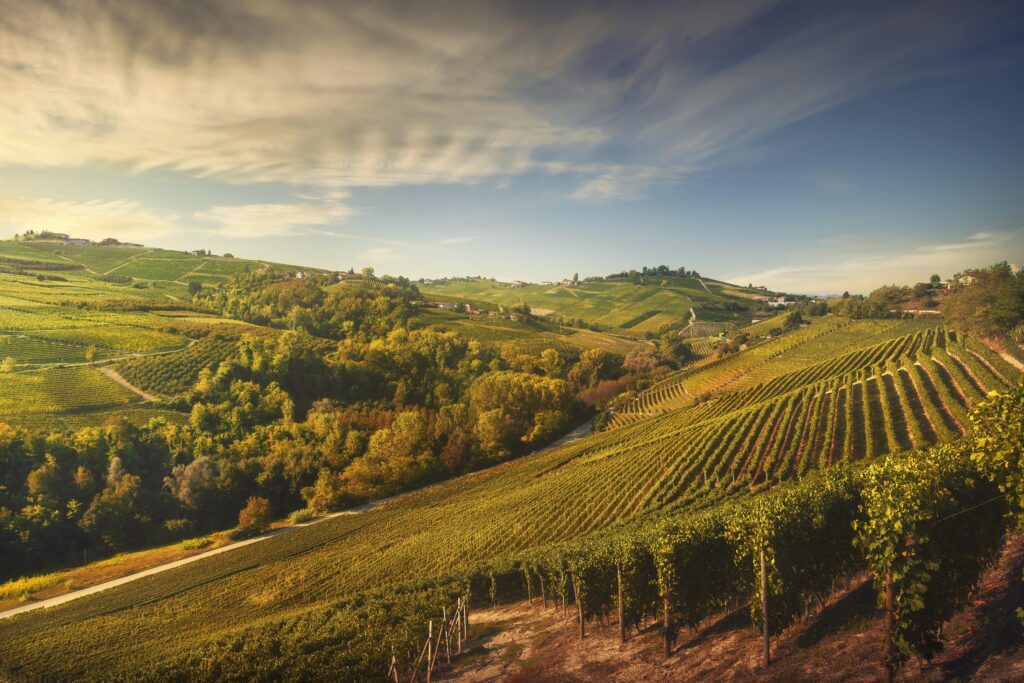- Home
- Moscato d’Asti: Characteristics and History
Moscato d’Asti: Characteristics and History
Origins and peculiarities of Moscato d'Asti, king of dessert wines
The fascinating hills between Monferrato and Langhe were declared a UNESCO heritage site in 2014. Among the evocative panoramic views and vineyards, which are lost on the horizon, the wine culture of Piedmont represents a mix of harmony, balance, and respect for the territory. The result? The production of Moscato d’Asti, the irreplaceable dessert wine that follows the lines of Nizza Monferrato, Barbera d’Asti, and Asti, the sparkling wine from Canelli produced with the Charmat or Martinotti method.
Organoleptic characteristics of Moscato d’Asti
Moscato d’Asti DOCG catches the eye of the taster with its unique straw yellow color. Sweet but not cloying, it releases an aromatic and characteristic scent. The palate recalls lime, wisteria, lemon, citrus, and orange. The floral and fruity notes guarantee a wisely balanced mix of sweetness and body, which envelops the palate and mixes with the varied Piedmontese culinary tradition. Although Moscato d’Asti is traditionally paired with sweets and desserts – tarts, tiramisu, almonds, sweets, and cheesecake – it also accompanies savory and spicy Thai and Indian dishes, as well as figs and melon.
This is the case of our Campo del Palio Moscato d’Asti DOCG, extracted from sweet and fragrant grapes. The same goes for the clear and amber-colored Moscato Grappa. With its intense notes of ripe fruit and honey, Moscato Grappa is one of the best Piedmontese grappas.

History of Moscato d’Asti
Moscato d’Asti originates from white Moscato, a grape variety with intensely aromatic and sweet components, which has spread throughout the Mediterranean basin since the times of the Hellenic and Latin dominations. The etymology of the name Moscato, which comes from the Greek word moskhos (musk), further witnesses the ancient roots of this wine.
Moscato d’Asti has contributed spreading the oenological tradition of Piedmont. Indeed, Piedmontese winemakers have always produced these low alcoholic wines with unforgettable aromas. In the sixteenth century, Giovan Battista Croce, Carlo Emanuele I’s jeweler, codified for the first time the winemaking rules for Moscato d’Asti. The DOC was recognized in 1967, while the DOCG dates back to 1993.
Nowadays, Moscato d’Asti is one of the best white wines of Northern Italy; Piedmontese winemakers are committed to its constant improvement. The characteristics of Moscato d’Asti celebrate the geological and climatic richness of an extremely generous region, which extends over three provinces of southern Piedmont: Alessandria, Asti, and Cuneo.

World recognition for Moscato d’Asti
Moscato d’Asti symbolizes wine quality and Italian excellence thanks to the meticulous methodology of its production, packaging, and export. Wine is the greatest pride of Piedmont and has crossed the Alpine borders to reach many European and non-European countries, in particular Germany, the United States, and Russia. Approximately 88% of Moscato d’Asti is exported.
The international success results from the commitment of local farmers, big wineries, and small producers, who work in synergy in a vast area of 52 villages and towns. The use of roller crushers allows preserving the integrity of the berries, as established by the canons dating back to the early decades of the sixteenth century. To prevent fermentation, Moscato d’Asti is kept at low temperatures before being bottled and exported. Its denomination has conquered the whole world.
Campo del Palio Moscato d’Asti DOCG
Among Cantine Povero portfolio, we recommend Campo del Palio Moscato d’Asti. This sweet wine has a straw yellow color with golden nuances and a fine and persistent perlage. Countless of aromas stand out, such as white musk, sage, pear, apricot, honey, roses, orange peel, and orange blossom. The palate is fragrant, fresh, and purely sweet. It is mainly a wine for the end of a meal, which goes well with various types of tarts, cheesecakes, fruits such as figs and melon, and tasty cheeses such as gorgonzola and stilton.

Moscato Spumante
If you love sparkling wines, we recommend Moscato Spumante, produced with the Charmat method. The color is straw yellow with golden reflections and the perlage is fine and persistent. This delicious sparkling wine features initially intense notes of apricot and peach, and grapes and honey on the finish. Excellent in combination with brioches, sponge cakes, and pandoro.Grappa Moscato
This grappa comes from the pomace of Moscato grapes. The elegant bouquet has notes of chocolate, toasted nuts, and vanilla, given by the aging in wood. The palate is velvety and persistent and stands out for its frankness and balance. Excellent with coffee or dark chocolate.






